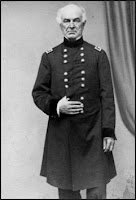 As February turned into March of 1862, Henry Halleck's strenuous efforts to supersede U.S. Grant with Ethan Allen Hitchcock (right) bore strange fruit. The pro-Hitchcock arguments so arduously pitched at McClellan and the retired Scott (and presumably through them at Lincoln and Stanton) had morphed into a project to replace McClellan with Hitchcock.
As February turned into March of 1862, Henry Halleck's strenuous efforts to supersede U.S. Grant with Ethan Allen Hitchcock (right) bore strange fruit. The pro-Hitchcock arguments so arduously pitched at McClellan and the retired Scott (and presumably through them at Lincoln and Stanton) had morphed into a project to replace McClellan with Hitchcock.As most readers outside the orbit of Centennial history know, this development reached its final stage in an interview with Hitchcock in March of '62 during which he was offered the general-in-chief's portfolio and the AoP by Stanton.
Hitchcock rejected the idea of replacing McClellan and deployed a metaphor. His diary tells us that he said, in this interview, that an army was like a living organism and to remove the head of the army was to do irreparable damage the whole.
If we extend that metaphor we could say that the individual organs of this system are also terribly affected by such changes.
As with many things in Civil War history, the reader understands this with head but not with heart. The march from McClellan to Pope to McClellan to Burnside to Hooker to Meade to Grant/Meade is often viewed as a necessary evil. But to look at the tenure of corps commanders in the east - the layer under these chiefs - is to immediately understand that Lincoln and Stanton unleashed untold trauma upon their own cause - repeatedly.
This is what struck me perusing unit data in Civil War Battle Flags. It is presented visually in a striking way: any HQ (for corps, division, etc) is shown with a series of commanders and a series of incumbency dates (change of command dates). Where a reference like Eicher's and Eicher's Civil War High Commands shows incumbency dates by person, Flags gives a snapshot of the turnover by unit. The personality-centered view of the Civil War is here switched for a view of the institutional health of the corps and division formations.
The Flags information shows violent turbulence.
The first table below processes rough data I collected from Flags. It has been calculated and arranged to produce a multi-corps view (in order of corps designation). I rounded and shaved fractions to ready a quick posting.
 The second column shows how long the corps "lived" in months, with rounding for partial months of existence for a corps formation. My bias was on the side of longevity, not brevity (and in at least two cases I did not bother to factor in brief hiatuses when the organization's existence was suspended). This means my average tenures are longer than the reality. The third column shows the number of persons who commanded while the fourth column shows the instances of command, in other words changes of command. Since a commander could be reassigned and then return to the corps, column 3 will be less than column 4 in many cases. The numbers of changes of command (column 4) include temporary command situations and are the truer indicator of instability than the number of commanders (persons commanding).
The second column shows how long the corps "lived" in months, with rounding for partial months of existence for a corps formation. My bias was on the side of longevity, not brevity (and in at least two cases I did not bother to factor in brief hiatuses when the organization's existence was suspended). This means my average tenures are longer than the reality. The third column shows the number of persons who commanded while the fourth column shows the instances of command, in other words changes of command. Since a commander could be reassigned and then return to the corps, column 3 will be less than column 4 in many cases. The numbers of changes of command (column 4) include temporary command situations and are the truer indicator of instability than the number of commanders (persons commanding).Note that two units stand out with longer average tenures, VII Corps and VIII Corps: for much of the war, these were actually departmental armies generally outside of the AoP structure. They were not affected by new appointments to the AOP nor by shifts stemming from campaign results. In fact, have a look at the same table reordered to show unit by tenure ranking:
 The overall average tenure for a corps commander in these eastern outfits is a grotesque 5.16 months, with a laughable two months at the top of the instability scale. If we take away Dix's and Wool's VII and VIII Corps, the average tenure in the remaining nine corps drops to a shocking average of 4.3 months per corps before commanders changed.
The overall average tenure for a corps commander in these eastern outfits is a grotesque 5.16 months, with a laughable two months at the top of the instability scale. If we take away Dix's and Wool's VII and VIII Corps, the average tenure in the remaining nine corps drops to a shocking average of 4.3 months per corps before commanders changed.This is a record I believe to be unique in American history. It represents a catastrophe in the personnel management of the Union high command.



